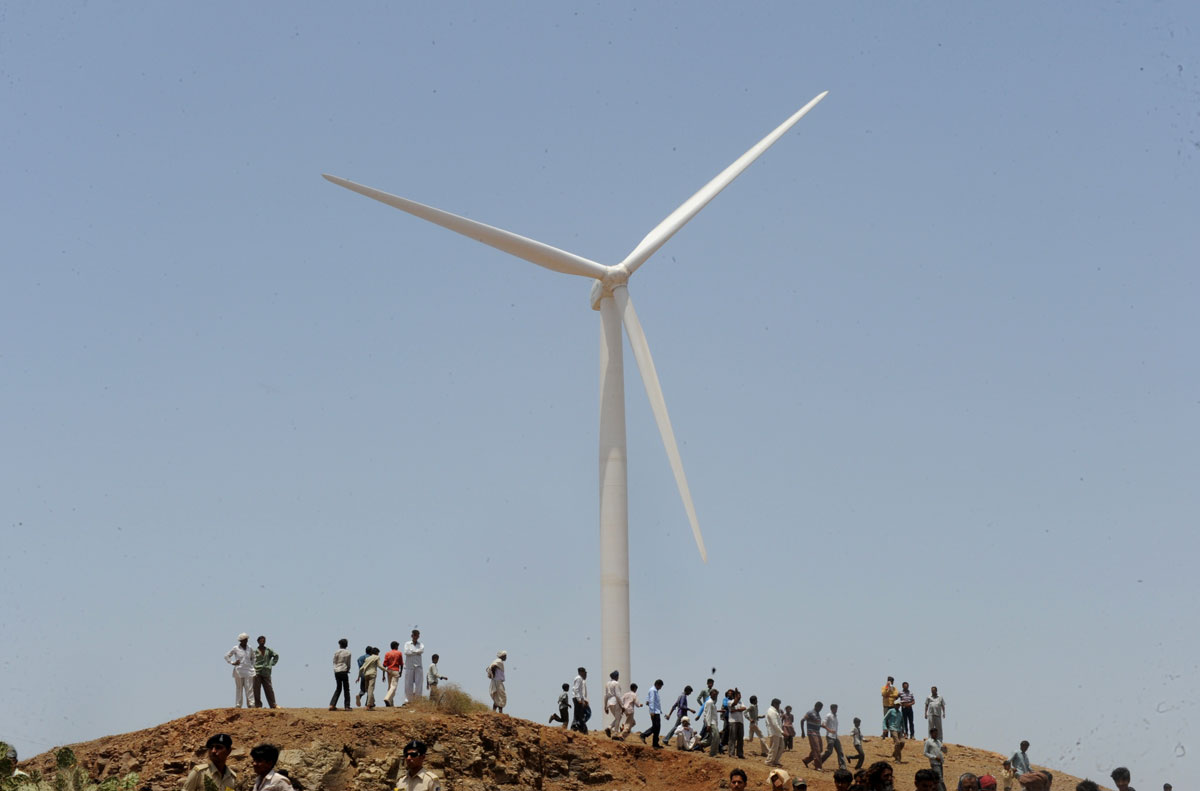WINDS OF CHANGE IN INDIA
Indian villagers gather in front of a wind turbine at Jasdan town, some 200 kms from Ahmedabad, May 6, 2012. Erstwhile Gujarat Chief Minister Narendra Modi inaugurated a 25.2 MW wind farm of ReNew Power consisting of 12 units of Suzlon S88 wind turbines with 2.1 MW capacity each at Jasdan. (San Panthaky/AFP/GettyImages)
The direction of development and technological innovation impacts the topography of a region or country for the good or the bad. For instance, those traveling to Kochi by air can be mesmerized by the aerial view of thousands of solar panels spread over several acres of land. The clean power generated feeds the airport. One also gets a sense of the squalor and congestion in Mumbai, as the plane travels over several hundreds of meters of slum dwellings, before landing, writes Siddharth Srivastava. – @Siliconeer #Siliconeer #narendramodi @namo #namo #windenergy #India #windturbine #development
The telecom revolution in India has bred eyesores in the form of signal towers that have mushroomed in residential areas. Some erected illegally on top of private dwellings for a commission are severely criticized for weakening the foundations of buildings. Several scientific studies have warned that powerful waves emanating from the towers can damage human tissues, including the brain, with children and elderly particularly vulnerable. Moving on from the rapid rise in use of cell phones in India, a road-trip in many parts of the country is no longer just about whizzing past farmlands, dhabas, gas stations, brick kilns and stopping at highway toll booths.
The spatial spread of investments in organized retail is widening. Multi-storied malls have mushroomed along major highways, so have drive-through KFCs and McDonalds, Cafe Coffee Day and Barista outlets, Haldiram and Bikanerwala. Road travellers have the choice of sitting on a charpai to sip extra sweet milk tea or walk a few meters to a CCD to order a freshly brewed cappuccino. If lucky, they could witness a Harley Davidson bike group ride past, another novelty that was not visible on Indian highways just a while back.
If the Modi government is able to implement its plans, another technological marvel that is a common sight in several parts of Europe, Australia and America, could become a reality in India. It is in the form of large windmills. While attention has been on solar power, over recent weeks New Delhi has been making efforts to streamline paradigms linked to the wind sector. India ranks fourth globally with nearly 28 GW installed wind capacity, but plants suffer from low capacity utilization amidst allegations that investments have been made largely to create land banks even as wealthy investors have availed tax benefits.
Re-powering windmills. Among the significant changes announced by the ministry of new and renewable energy (MNRE), are plans to auction 10 GW of wind power by 2019 via competitive bidding as in the case of solar. The first 1000 MW is planned for this year. Varsha Joshi, joint secretary in MNRE recently said, “The government is working to raise the share of green power from all the states’ grids over the next three years. We’re chalking out a road map for wind auctions in order to enable states to fulfill the upcoming new (renewable) purchase obligations (or RPO) and are thinking of around 10 GW to be tendered by 2019. The auction format being developed will allow wind-poor states to source clean energy from windier ones.”
Wind plant developers are expecting market bidding to gradually replace feed-in tariffs to mirror the way solar projects have been successfully awarded. Such auctions are likely to lead to drop in wind power pricing as happened in solar. This is essential for wind to compete with other generators, including thermal or electricity generated by polluting coal-fired plants. Cash-strapped state-owned distribution companies or discoms across the country are very sensitive to pricing. They will readily opt for cheaper thermal power given a choice. The MNRE has also recently announced a policy aimed at re-powering of wind projects and turbines with capacity of one MW or less.
Re-powering allows for replacement of ageing wind turbines, many installed over a decade-and-half-back, with powerful and modern units to enhance generation. MNRE has calculated that over 3000 MW wind capacity in India is from wind turbines of 500 KW or less. It is estimated the re-powering potential in India is nearly 3.5 GW of wind turbines, with about 2 GW just in Tamil Nadu. As per the policy laid out by MNRE, re-powered wind plants will be eligible for fiscal incentives, including Accelerated Depreciation and Generation Based Incentive, that are applicable only for new wind projects. The Indian Renewable Energy Development Agency will dispense an interest rate discount of 0.25% for re-powering, in addition to incentives that are already being provided to new clean energy projects.
Welcoming the changes, Tulsi Tanti, chairman and managing director, Suzlon Group, said, “There is opportunity for re-powering in Maharashtra, Gujarat and Tamil Nadu, since they were amongst the early adopters of wind energy way back in 1990s and the wind turbines are nearing the end of their lifecycle.” Progress can change the physical features of any country. Solar panels are already visible at airports and railway stations in India. It could be the turn of windmills to alter the landscape further, hopefully, benefiting the residents of the area.


